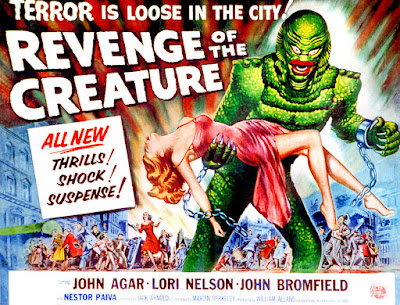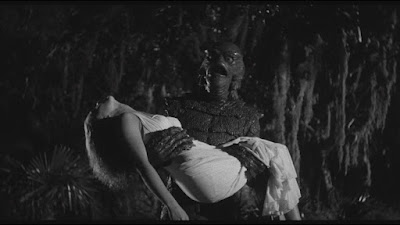*** (out of ****)
Elvira ("playing herself") and her maid, Zou Zou (Mary Jo Smith) are awaken from their sleep when an innkeeper (Theodor Danetti) aggressively pounds on the door asking for his money. The two become frantic as the innkeeper begins to smash the door down with a ax. He peeks his head through the door and announces "hereeee's Johan!" - a la the famous Jack Nicholson scene in Stanley Kubrick's "The Shining" (1980) - the camera speed is sped up as the two women quickly collect their things and jump out of the window, while a poor imitation of Romanian gypsy folk music plays in the background.
This scene immediately establishes the tone and the humor of the rest of the movie which can best be described as "campy", "juvenile", and "bawdy". I would also call it - surprisingly - infectious!
"Elvira's Haunted Hills" (2001) was a direct-to-video movie made on a modest budget and shot on location in Romania. It was dedicated to Vincent Price - the movie's title recalls the William Castle horror movie, "House on Haunted Hill" (1959) starring Price - but actually owes a lot, aesthetically, to the Edgar Allan Poe movie adaptations directed by Roger Corman, nearly all of which starred Price as well.
Set in the Carpathian Mountains in 1851 - the same year Mary Shelley died and Nathaniel Hawthorne wrote The House of the Seven Gables - Elvira is an entertainer trying to make her way to Paris in time for the opening of a new revue she is starring in, "Yes, I Can-Can". Broke, hungry, and tired, the two ladies are rescued when the coach of Dr. Bradley Bradley (Scott Atkinson) passes by. He is on his way to the castle of Lord Hellsubus (Richard O'Brien, writer of The Rocky Horror Show) where the ladies can spend the night and head off to Paris the next morning.
It is at the castle events begin to take a strange turn. It is believed the castle is haunted by the spirits of the Hellsubus family. These spirits may have been the cause of Lord Hellsubus' first wife, Elura (Cassandra Peterson) committing suicide. Could it be she was driven mad by the spirits? Although he is now remarried to Ema (Mary Scheer), Lord Hellsubus is still tortured by the death of Elura, on what is the eve of the 10th anniversary of her death. The situation becomes further complicated for Elvira after she learns she is a dead ringer for the deceased wife.
Traces of this story can be seen in several of Corman's Poe adaptations including "The Tomb of Ligeia" (1964), "The Pit and the Pendulum" (1962), "The Fall of the House of Usher" (1960), and "The Haunted Palace" (1963).
Where "Elvira's "Haunted Hills" goes wrong, in the realm of the comedy / horror genre, is by not taking the horror portion of the story serious. Comedy / horror is really two movies in one. The horror element of the plot needs to be strong enough to stand alone as its own feature film. The scarier the premise the easier the infusion of comedy should be. The comedy will naturally lend itself to the situation instead of feeling forced. The audience will be laughing at the irrational behavior the characters engage in as they are consumed by fear.
"Elvira's Haunted Hills" had enough material to constitute a decent enough storyline able to elicit some chills however the comedy dominates the horror aspects of the movie. Despite the appearance of Elvira, the dedication to Vincent Price, and the borrowing of Edgar Allan Poe and Roger Corman, the movie primarily views itself as a comedy. The other problem with the movie is everything is a wink and smile. Everyone knows they are in a campy movie and rather than play against the impulse to ham it up the actors speak with silly accents and express themselves with wild facial and hand gestures. The worst offender is Mary Scheer. It is amazing none of these performers know playing comedy straight would have been much funnier. The great filmmaker Howard Hawks later critiqued his own comedy, "Bringing Up Baby" (1938) stating the flaw of the movie was every character was crazy, "there were no normal people in it" as he put it.
While everyone in the movie is cranking their performances up to an 11, the humor in the movie is playfully raunchy, placing a great emphasis on Elvira's large bosom. There are a lot of breast jokes in "Elvira's Haunted Hills". After Dr. Bradley offers the ladies a ride, they end up going over some bumpy roads, causing the coach and the passengers to bounce around. Of course their actions are greatly exaggerated and as Dr. Bradley and Elvira bounce around, he somehow always ends up with his hands on her breasts or in one moment, with his face in-between them. Another reoccurring gag revolves around how much Zou Zou is able to stuff between her breasts, from a pocket mirror to a blood sausage!
The rest of the humor in the movie is self-referential, again going back to that wink and smile mentality. As one character is having an emotional break down, Elvira smacks him, declaring what is he trying to do? Go for an Oscar! At another moment she comments on one of the special effects, delighted the movie was able to accomplish it on its small budget. And finally, they even poke fun at some of the bad dubbing found in horror movies, especially the Italian ones directed by masters like Dario Argento and Mario Bava. One character's mouth is never in synch with his words, which Elvira comments on.
The true objective of the movie is to showcase Cassandra Peterson's alter ego Elvira. It's no surprise Peterson co-wrote the script (along with John Paragon, whom you may recall from TV's "Pee-Wee's Playhouse" as Jami the Genie). A pot-boiler like this would be fine and dandy if Elvira was an established and beloved comedic character. Perhaps in some circles she is. In the vain of the great comedians of the past, the concept here is to place the well known personality in an unusual setting juxtaposed against their contemporary humor. Think Laurel & Hardy in "Way Out West" (1937), Woody Allen in "Love and Death" (1975), or Bob Hope in any number of comedies like "Casanova's Big Night" (1954) or "Alias Jesse James" (1959). While I hate to compare this movie to something far superior like a Bob Hope comedy, "Elvira's Haunted Hills" takes that similar approach in its use of anachronistic humor.
I didn't find "Elvira's Haunted Hills" to be as inspired a comedy as "Airplane!" (1988) or the "Naked Gun" movies but I did like its spirit. I sometimes have a penchant for this kind of broad comedy. The movie I thought of most while watching this was "The Silence of the Hams" (1994), a completely forgettable comedy starring Dom DeLuise. I may be the only person that remembers that movie. It is not available on DVD or Blu-ray and has become a rarity on VHS. When I saw it as a kid, I absolutely loved it! "Elvira's Haunted Hills" gave me that same giddy feeling while it throws in its titillating humor.
One reason "Elvira's Haunted Hills" may not work as well as it could might have to do with the source material - Corman's movies. I am reminded of something the film critic Roger Ebert wrote when reviewing the Mel Brooks comedy, "High Anxiety" (1977). Brooks' movie spoofed the films of Alfred Hitchcock, Ebert felt the movie as a whole didn't work because the films of Hitchcock were already funny themselves. "Almost all of Hitchcock's fifty-three or so films have their great moments of wit" Ebert stated "And wit - the ability to share a sense of subtle fun with an audience - is not exactly Brooks's strong point." Roger Corman's movies on the other hand are pretty campy to begin with. "Elvira's Haunted Hills" can't out camp something campy to begin with.
If you are unfamiliar with the Elvira character, she was a very popular figure to my generation (80s babies) as the host of a TV show called "Movie Macabre with Elvira, Mistress of the Dark" which would air "B" horror movies. In-between the movie she would tell jokes. Here in Chicago we have had our own version of this for decades, Svengoolie, which airs on Me-TV and has gone national. The Elvira character reached such a level of pop culture fame, she eventually starred in her own movie, "Elvira: Mistress of the Dark" (1988). Cassandra Peterson developed the character while part of the improve comedy group, The Groundlings, which is where people like the late Paul Reubens and Phil Hartman got their start.
"Elvira's Haunted Hills" is a mixed-bag comedy / horror movie. It doesn't have much in way of horror, despite ample opportunity, but its comedy is silly and infectious even though the actors allow their worst comedy instincts to sometimes take over. In its own way it is a fitting and charming tribute to the movies of Roger Corman.



























